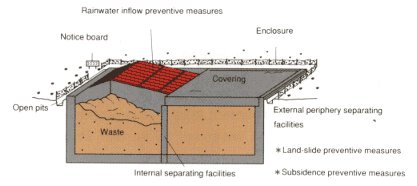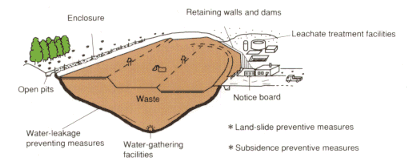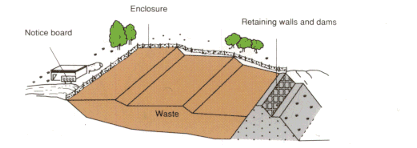Waste & Recycling
Waste Disposal and Recycling Measures
1. Responsibilities for Waste Disposal
Wastes are classified into two categories in Japan: municipal and industrial. The disposal of municipal wastes is the responsibility of the municipalities. The disposal of industrial wastes is the responsibility of the entities that generate the wastes.
2. Countermeasures by the Environment Agency
Waste treatment in Japan is performed based on the "Waste Disposal and Public Cleansing Law." The Environment Agency is responsible for setting up the standards for landfill waste, landfill site structure, and landfill site operation and maintenance.
(1) Standards for Landfill Waste
Landfilling of hazardous wastes shall be carried out at sites that are isolated from public waters and groundwater. Certain wastes shall be pre-treated by methods such as water removal, crushing, incineration, or cutting. Measures shall be taken to prevent offensive odors from leaking out of the landfill sites and to prevent the breeding of rats, mosquitoes, and other vermin.
(2)Standards for Landfill Site Structure and for Landfill Site Operation and Maintenance
Landfills are classified into three types: isolated, leachate-controlled, and non-leachate-controlled. Isolated landfills are used for the disposal of hazardous industrial wastes. Leachate-controlled landfills are used for the disposal of both municipal and industrial wastes other than hazardous and stable wastes. Non-leachate-controlled landfills are used for the disposal of stable wastes, namely, waste plastics, rubber scrap, metal scrap, waste glass, ceramics, and demolition waste. The standards for landfill site structure and those for landfill site operation and maintenance have been established in accordance with landfill type.
Trend of total and unit generation amounts of domestic wastes

Generated Amounts of Industrial Wastes(tons/year)
| Type | FY1993 | FY1994 | Recycling ratio |
|---|---|---|---|
| Cinders | 2,696 | 4.413 | 8 |
| Sludge | 180,490 | 184,127 | 4 |
| Waste oil | 2,749 | 3.062 | 44 |
| Waste acid | 2,771 | 4,678 | 48 |
| Waste alkali | 1,538 | 2,143 | 26 |
| Waste plastics | 5,348 | 5,771 | 24 |
| Waste rubber | 71 | 82 | 25 |
| Waste metal | 6,028 | 6,499 | 93 |
| Waste glass and ceramics | 6,020 | 6,431 | 26 |
| Waste paper | 1,683 | 1,817 | 78 |
| Wood waste | 6,948 | 7,881 | 44 |
| Fibers waste | 114 | 78 | 65 |
| Slag | 3,219 | 4,376 | 82 |
| Construction wastes | 30,867 | 31,117 | 44 |
| Livestock excreta | 61,541 | 60,238 | 94 |
| Livestock corpses | 75,567 | 74,553 | 89 |
| Dust | 75 | 132 | 50 |
| Other treated industrial wastes | 9,144 | 8,054 | - |
| Total | 396,869 | 405,455 | - |
Fig 1 Landfill site for hazardous industrial wastes (Isolated type)

Fig 2 Landfill site for domestic wastes and industrial wastes (Leachate-controlled type)

Fig 3 Landfill site for stable industrial wastes (Non-leachate-controlled type)

Standards for Verification (hazardous substances containing wastes)
| Disposal method | Landfill | Dumping at sea | ||
|---|---|---|---|---|
| Hazardous substances | Cinder dust sludge slag (mg/l) | Organic sludge (mg/kg) | Waste acid waste alkali (mg/l) | Inorganic sludge (mg/l) |
| alkylmercury compounds | ND | ND | ND | ND |
| mercury and its compounds | 0.005 | 0.025 | 0.025 | 0.0005 |
| cadmium and its compounds | 0.3 | 0.1 | 0.1 | 0.01 |
| lead and its compounds | 0.3 | 1 | 1 | 0.01 |
| organic phosphorous compounds | 1 | 1 | 1 | ND |
| chromium (VI) compounds | 1.5 | 0.5 | 0.5 | 0.05 |
| arsenic and its compounds | 0.3 | 0.15 | 0.15 | 0.01 |
| cyanides | 1 | 1 | 1 | ND |
| PCBs | 0.003 | 0.003 | 0.003 | ND |
| trichloroethylene | 0.3 | 0.3 | 0.3 | 0.03 |
| tetrachloroethylene | 0.1 | 0.1 | 0.1 | 0.01 |
| dichloromethane0.20.20.20.02 | ||||
| carbon tetrachloride | 0.02 | 0.02 | 0.02 | 0.002 |
| 1,2-dichloromethane | 0.04 | 0.04 | 0.04 | 0.004 |
| 1,1-dichloroethylene | 0.2 | 0.2 | 0.2 | 0.02 |
| cis-1,2-dichloroethylene | 0.4 | 0.4 | 0.4 | 0.04 |
| 1,1,1-trichloroethane | 3 | 3 | 3 | 1 |
| 1,1,2-trichloroethane | 0.06 | 0.06 | 0.06 | 0.006 |
| 1,3-dichloropropene | 0.02 | 0.02 | 0.02 | 0.002 |
| thiuram | 0.06 | 0.06 | 0.06 | 0.006 |
| simazine | 0.03 | 0.03 | 0.03 | 0.003 |
| thiobebncarb | 0.2 | 0.2 | 0.2 | 0.02 |
| benzene | 0.1 | 0.1 | 0.1 | 0.01 |
| selenium and its compounds | 0.3 | 0.1 | 0.1 | 0.01 |
| organic chlorine compounds | - | 4 | 4 | 1 |
| copper and its compounds | - | 10 | 10 | 0.14 |
| zinc and its compounds | - | 20 | 20 | 0.8 |
| fluorides | - | 15 | 15 | 3 |
| beryllium and its compounds | - | 2.5 | 2.5 | 0.25 |
| chromium and its compounds | - | 2 | 2 | 0.2 |
| nickel and its compounds | - | 1.2 | 1.2 | 0.12 |
| vanadium and its compounds | - | 1.5 | 1.5 | 0.15 |
| phenol | - | 20 | 20 | 0.2 |
3. Towards Environmentally Sound Material Cycle
As our social economic activities become more and more characterized by mass-production, mass-consumption and mass-disposal, the increased volume and diversification of wastes being disposed of raised the nation's concern about the burden they exert on the environment and the environmental pollution relating to landfill wastes.
In this backdrop, the Central Environmental Council submitted a primary report on measures to reduce environmental impact relating to waste disposal on November 4, 1997.
In the report, the following three proposals were made.
- [1]
- Strengthen standards relating to the landfilling of waste
- [2]
- Use environmentally viable methods to recover harmful substances from products at the post-consumer stage including harmful substances such as lead or cadmium, and promote recycling
- [3]
- Adopt integrated and systematic waste management and recovery measures
Based on this report, the Environment Agency shall [1] revise related government ordinances, such as standards for landfill waste; [2] formulate plans to reduce the environmental impact of harmful substances in products at the post-consumer stage; and [3] appoint the Council to continue review the subject with a view to establishing an integrated waste management and recovery system and realizing a desirable material cycle.
Summary of the primary report of the Central Environmental Council "Concerning measures for the reduction of environmental loads relating to waste disposal"
- [1] Strengthen standards relating to the landfilling of waste
The following standards relating to the landfilling of waste shall be strengthened: standards for landfill site structure such as water-leakage preventing measures and standards for landfill site operation and maintenance such as water quality monitoring. - [2] Use measures to reduce the environmental load of products containing harmful substances at the post-consumer stage
The following measures shall be taken to reduce the environmental load of harmful substances in products at the post-consumer stage: reduce the amount of harmful substances used in products; establish a social system for the recollection and reuse of harmful substances; and gather quantitative information relating to the harmful substances contained in products. - [3] Adopt integrated and systematic waste disposal and recycling measures
The current practice of "properly processing the disposed wastes" has seen its limit in solving today's waste problem. It is necessary to adopt an integrated and systematic waste management and recovery system to reduce environmental load at every step of the material cycle, from procurement to disposal. Continuous studies shall be carried out to facilitate the establishment of such system and to realize a desirable material cycle.